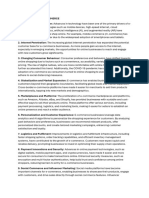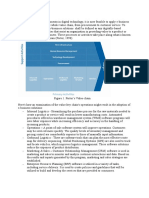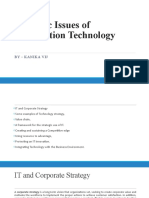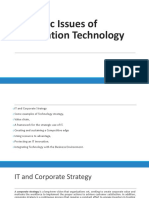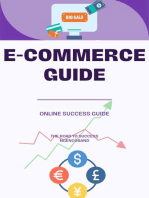0 ratings0% found this document useful (0 votes)
4 viewsAssignment
Assignment
Uploaded by
khusboo870021B.com assignment
Copyright:
© All Rights Reserved
Available Formats
Download as DOCX, PDF, TXT or read online from Scribd
Assignment
Assignment
Uploaded by
khusboo8700210 ratings0% found this document useful (0 votes)
4 views7 pagesB.com assignment
Original Title
assignment
Copyright
© © All Rights Reserved
Available Formats
DOCX, PDF, TXT or read online from Scribd
Share this document
Did you find this document useful?
Is this content inappropriate?
B.com assignment
Copyright:
© All Rights Reserved
Available Formats
Download as DOCX, PDF, TXT or read online from Scribd
Download as docx, pdf, or txt
0 ratings0% found this document useful (0 votes)
4 views7 pagesAssignment
Assignment
Uploaded by
khusboo870021B.com assignment
Copyright:
© All Rights Reserved
Available Formats
Download as DOCX, PDF, TXT or read online from Scribd
Download as docx, pdf, or txt
You are on page 1of 7
NAME – ANKITA SHARMA
COURSE – B.COM
YEAR – 3RD YEAR
ROLL NUMBER – 588
SUBJECT – INTERNATIONAL BUSINESS ASSIGNMENT
Analysis
Key Technological Disruptions:
1. E-commerce Platforms: The rise of e-commerce platforms, such as
Amazon and Alibaba, has transformed the retail landscape. Consumers
can now shop for a wide range of products online, often at competitive
prices, without the need to visit physical stores.
2. Mobile Commerce:The proliferation of smartphones has enabled
mobile commerce, allowing consumers to shop conveniently using
mobile apps or websites. Mobile commerce offers flexibility and
accessibility, with consumers able to make purchases on the go.
3. Data Analytics:Retailers can now collect and analyze vast amounts of
customer data to understand shopping behaviors, preferences, and
trends. Advanced data analytics techniques enable retailers to
personalize marketing campaigns, improve inventory management,
and enhance overall decision-making.
4. Artificial Intelligence (AI) and Machine Learning:AI-powered
technologies are revolutionizing various aspects of retail, including
demand forecasting, customer service, and product recommendations.
Machine learning algorithms analyze large datasets to predict
consumer preferences and optimize business operations.
5. Augmented Reality (AR) and Virtual Reality (VR): AR and VR
technologies offer immersive shopping experiences, allowing
consumers to visualize products in their physical environment or
explore virtual stores. These technologies enhance engagement and
provide a more interactive shopping experience.
Challenges:
- Intense Competition: Traditional retailers face fierce competition from online
giants and emerging e-commerce startups, challenging their market share
and profitability.
- Adaptation Costs: Implementing new technologies requires significant
investment in infrastructure, training, and system integration, posing
financial challenges for traditional retailers.
- Data Privacy Concerns: Collecting and utilizing customer data raise privacy
concerns, requiring retailers to comply with stringent regulations and build
trust with consumers.
Opportunities:
- Enhanced Customer Experience: Technology allows traditional retailers to
personalize interactions, offer targeted promotions, and provide seamless
omnichannel experiences, distinguishing them from competitors.
- Operational Efficiency: Automation and data analytics enable retailers to
streamline processes, optimize inventory management, and reduce costs,
improving overall efficiency and profitability.
- Global Reach: E-commerce platforms provide traditional retailers with the
opportunity to expand their reach beyond physical boundaries and target
global markets, driving growth and revenue.
Impact on Consumer Behavior- Convenience: Consumers prioritize
convenience and expect retailers to offer flexible shopping options such as
mobile commerce and same-day delivery.
- Personalization: Consumers appreciate personalized recommendations
and tailored shopping experiences based on their preferences and past
interactions.
- Transparency: Consumers demand transparency regarding product
information, pricing, and ethical practices, influencing their purchasing
decisions and brand loyalty.
Example: A traditional retail chain can leverage data analytics to analyze
customer purchase history and preferences. Using this information, the
retailer can send personalized email offers or mobile app notifications to
customers, showcasing products tailored to their interests. For instance, if a
customer frequently purchases athletic wear, the retailer can send a discount
offer for new arrivals in the sports apparel category.
Analysis
Strategic Recommendations:
1. Enhance Customer Experience:
- Leverage Technology: Implement advanced data analytics and AI-powered
solutions to personalize customer interactions, offer targeted promotions,
and provide seamless omnichannel experiences.
- Example: A traditional retail chain can use AI chatbots on their website
and mobile app to provide personalized product recommendations and assist
customers with inquiries in real-time.
Strategic Recommendations:
1. Enhance Customer Experience:
- Leverage Technology: Implement advanced data analytics and AI-powered
solutions to personalize customer interactions, offer targeted promotions,
and provide seamless omnichannel experiences.
Example: A traditional retail chain can use AI chatbots on their website and
mobile app to provide personalized product recommendations and assist
customers with inquiries in real-time.
2. Improve Operational Efficiency:
- Adopt Automation: Automate routine tasks such as inventory
management and order processing using AI and robotic process automation
(RPA) to streamline operations and reduce costs.
- Example: A traditional retailer can implement an AI-powered inventory
management system that automatically replenishes stock based on demand
forecasts, reducing the risk of stockouts and overstocking.
3. Drive Growth: - Expand Online Presence: Invest in e-commerce
infrastructure and digital marketing to reach a broader audience and tap into
new markets beyond physical boundaries.
- Example: A traditional brick-and-mortar retailer can launch an online
marketplace to sell products to customers nationwide, offering convenience
and accessibility.
Potential Risks and Mitigation Strategies:
1. Data Privacy Concerns:- Risk: Collecting and utilizing customer data
may raise privacy concerns and damage trust.
- Mitigation: Implement robust data protection measures, obtain consent
for data collection, and comply with regulations such as GDPR and CCPA.
Communicate transparently with customers about data usage and privacy
policies.
2. Cybersecurity Threats: - Risk: Increased reliance on digital platforms
exposes the business to cybersecurity threats such as data breaches.
- Mitigation: Invest in cybersecurity solutions, conduct regular security
audits, and provide employee training on cybersecurity best practices.
Implement encryption and multi-factor authentication to safeguard sensitive
data.
3. Technological Integration Challenges: - Risk: Integrating new
technologies into existing systems may pose technical challenges and
disrupt operations.
- Mitigation: Conduct thorough testing and pilot programs before full
implementation, provide comprehensive training for employees, and
collaborate with technology partners for support. Develop a phased approach
to implementation to minimize disruptions.
Conclusion: In conclusion, traditional retail businesses must adapt and
leverage technology to thrive in the current business environment. By
enhancing customer experience, improving operational efficiency, and
driving growth through technology-driven initiatives, retailers can stay
competitive and meet the evolving needs of consumers. However, it is
essential to mitigate risks such as data privacy concerns, cybersecurity
threats, and technological integration challenges to ensure successful
implementation and sustainable growth.
Example: Walmart, a traditional retail giant, has successfully embraced
technology to enhance its business operations. The company utilizes AI and
data analytics to optimize inventory management, improve supply chain
efficiency, and personalize marketing efforts. Walmart's investment in e-
commerce infrastructure and digital initiatives has enabled it to compete
effectively with online retailers, driving growth and expanding its customer
base. Through strategic use of technology, Walmart continues to innovate
and adapt to the changing retail landscape, positioning itself for long-term
success.
Improve Operational Efficiency: - Adopt Automation: Automate routine
tasks such as inventory management and order processing using AI and
robotic process automation (RPA) to streamline operations and reduce costs.
Example: A traditional retailer can implement an AI-powered inventory
management system that automatically replenishes stock based on demand
forecasts, reducing the risk of stockouts and overstocking.
3. Drive Growth: - Expand Online Presence: Invest in e-commerce
infrastructure and digital marketing to reach a broader audience and tap into
new markets beyond physical boundaries.
Example: A traditional brick-and-mortar retailer can launch an online
marketplace to sell products to customers nationwide, offering convenience
and accessibility.
Potential Risks and Mitigation Strategies:
1. Data Privacy Concerns:- Risk: Collecting and utilizing customer data
may raise privacy concerns and damage trust.
- Mitigation: Implement robust data protection measures, obtain consent
for data collection, and comply with regulations such as GDPR and CCPA.
Communicate transparently with customers about data usage and privacy
policies.
2. Cybersecurity Threats: - Risk: Increased reliance on digital platforms
exposes the business to cybersecurity threats such as data breaches.
- Mitigation: Invest in cybersecurity solutions, conduct regular security
audits, and provide employee training on cybersecurity best practices.
Implement encryption and multi-factor authentication to safeguard sensitive
data.
3. Technological Integration Challenges: - Risk: Integrating new
technologies into existing systems may pose technical challenges and
disrupt operations.
- Mitigation: Conduct thorough testing and pilot programs before full
implementation, provide comprehensive training for employees, and
collaborate with technology partners for support. Develop a phased approach
to implementation to minimize disruptions.
Conclusion:
In conclusion, traditional retail businesses must adapt and leverage
technology to thrive in the current business environment. By enhancing
customer experience, improving operational efficiency, and driving growth
through technology-driven initiatives, retailers can stay competitive and
meet the evolving needs of consumers. However, it is essential to mitigate
risks such as data privacy concerns, cybersecurity threats, and technological
integration challenges to ensure successful implementation and sustainable
growth.
Example: Walmart, a traditional retail giant, has successfully embraced
technology to enhance its business operations. The company utilizes AI and
data analytics to optimize inventory management, improve supply chain
efficiency, and personalize marketing efforts. Walmart’s investment in e-
commerce infrastructure and digital initiatives has enabled it to compete
effectively with online retailers, driving growth and expanding its customer
base. Through strategic use of technology, Walmart continues to innovate
and adapt to the changing retail landscape, positioning itself for long-term
success.
Analysis
Key Findings:
1. Analysis of Technological Disruptions: - Traditional retail businesses
are facing significant disruptions from e-commerce platforms, mobile
commerce, data analytics, AI, and AR/VR technologies.
- These disruptions are reshaping consumer behavior, expectations, and
shopping habits, challenging traditional retailers to adapt and innovate.
2. Strategic Recommendations:- Enhance Customer Experience: Utilize
technology to personalize interactions, offer seamless omnichannel
experiences, and provide targeted promotions.
- Improve Operational Efficiency: Adopt automation and data analytics to
streamline processes, optimize inventory management, and reduce costs.
- Drive Growth: Expand online presence, invest in digital marketing, and
leverage technology to reach new markets and increase revenue.
Future Outlook:Traditional retail businesses face both challenges and
opportunities in the context of ongoing technological disruptions. While the
rise of e-commerce and digital technologies poses threats to brick-and-
mortar stores, it also opens up new avenues for growth and innovation.
Example:Consider the future outlook for a traditional department store
chain like Macy’s. By embracing technology and implementing strategic
recommendations, Macy’s can adapt to the changing retail landscape and
thrive in the digital age. For instance, Macy’s can enhance its customer
experience by leveraging AI-powered chatbots to provide personalized
assistance, implementing mobile commerce solutions for convenient
shopping, and utilizing data analytics to optimize inventory management and
tailor marketing campaigns. By integrating online and offline channels,
Macy’s can offer seamless omnichannel experiences and drive growth by
expanding its e-commerce presence and targeting new markets. Despite the
challenges posed by technological disruptions, Macy’s can position itself for
success by embracing innovation and leveraging technology to meet the
evolving needs of consumers.
You might also like
- Analysis of Case Study-Big Bazaar DirectDocument15 pagesAnalysis of Case Study-Big Bazaar DirectProtanu GhoshNo ratings yet
- Intra Organisational Commerce: AdvantagesDocument18 pagesIntra Organisational Commerce: AdvantagesMALLUPEDDI SAI LOHITH MALLUPEDDI SAI LOHITHNo ratings yet
- Business Uderstanding Solved1 - Module 1Document11 pagesBusiness Uderstanding Solved1 - Module 1pooja mukundeNo ratings yet
- AasthaDocument7 pagesAasthakhusboo870021No ratings yet
- BPSMDocument6 pagesBPSMankush sharmaNo ratings yet
- E-Business Assignment IIIDocument9 pagesE-Business Assignment IIINguvitjita MutateNo ratings yet
- Course - E-BusinessDocument12 pagesCourse - E-BusinessVINAYNo ratings yet
- Digital Marketing Trends and FutureDocument8 pagesDigital Marketing Trends and FutureEseogheneNo ratings yet
- E Com NotesDocument29 pagesE Com Noteskainatvalani25No ratings yet
- Ton Anan2Document6 pagesTon Anan2Kimberly VolfangoNo ratings yet
- AbdisamadDocument4 pagesAbdisamadStephen BarakaNo ratings yet
- E-Commerce ( )Document10 pagesE-Commerce ( )raukiraj37No ratings yet
- D BusinessssssDocument9 pagesD BusinessssssMinhas AliNo ratings yet
- Mis PP SolDocument8 pagesMis PP Solayeza.hasan2099No ratings yet
- E Business QBDocument17 pagesE Business QB1185 Saptik GhoshNo ratings yet
- E CommerceprojectDocument5 pagesE Commerceprojectsisayderiba936No ratings yet
- EcommerceDocument53 pagesEcommerceTushar GuptaNo ratings yet
- It Tools For CRM: Unit IiDocument62 pagesIt Tools For CRM: Unit IiNishant KoolNo ratings yet
- To Succeed in The Field of eDocument6 pagesTo Succeed in The Field of eநுட்பம் அறிதல்No ratings yet
- E-Business Ritik 24Document12 pagesE-Business Ritik 24anjnaprohike26No ratings yet
- E-Business ApuntesDocument46 pagesE-Business ApuntesSandraaNo ratings yet
- Chapter 1 Object Oriented ProgrammingDocument47 pagesChapter 1 Object Oriented Programmingbrunongetich4No ratings yet
- Strategic Formulation e ComDocument18 pagesStrategic Formulation e ComNavya AgarwalNo ratings yet
- MIS 12QsDocument14 pagesMIS 12Qsayeza.hasan2099No ratings yet
- Business UnderstandingDocument11 pagesBusiness UnderstandingSY ECE51 SHEJUL YUVRAJNo ratings yet
- E Commerce 1 UnitDocument3 pagesE Commerce 1 Unitlokeshburagana6No ratings yet
- Enterprise Resource PlanningDocument4 pagesEnterprise Resource PlanninggalvezivybsaNo ratings yet
- Tech & BusinessDocument3 pagesTech & BusinessLeo RajNo ratings yet
- Retail Psda 1Document3 pagesRetail Psda 1Kartikey DhimanNo ratings yet
- Assessment - BSBEBU511-SUMMATIVEDocument5 pagesAssessment - BSBEBU511-SUMMATIVEBảo Thy PhóNo ratings yet
- Steps For A Successful Twitter Marketing StrategyDocument10 pagesSteps For A Successful Twitter Marketing StrategySamarth PhutelaNo ratings yet
- Division B - ESDA Draft - B02Document6 pagesDivision B - ESDA Draft - B02anshitaamishra09No ratings yet
- Business & StrategyDocument30 pagesBusiness & StrategyVishal PatelNo ratings yet
- E - Business Sample Questions and AnswersDocument12 pagesE - Business Sample Questions and AnswersAkshay Kalawon100% (1)
- Introduction To Management Information SystemsDocument5 pagesIntroduction To Management Information SystemsDenis GikenyeNo ratings yet
- MIS - Tự LuậnDocument12 pagesMIS - Tự Luậnlongduongtiktok2024No ratings yet
- Cyber SecurityDocument39 pagesCyber Securitymsanusha2000No ratings yet
- MS RetailStoreSystemsDocument18 pagesMS RetailStoreSystemsladolcevita5No ratings yet
- Digital PracticeDocument36 pagesDigital Practicetp0603069No ratings yet
- Unit 5Document5 pagesUnit 5Furat MuhammedNo ratings yet
- Operations 2015 v4Document3 pagesOperations 2015 v4astrosecretszNo ratings yet
- Chapter 1. INTRODUCTION TO DIGITAL BUSINESS AND ECOMMERCEDocument26 pagesChapter 1. INTRODUCTION TO DIGITAL BUSINESS AND ECOMMERCEBless GelyNo ratings yet
- Document 1Document5 pagesDocument 1christian mediavilloNo ratings yet
- EshopDocument8 pagesEshopAlphonce Kiprono0% (1)
- Contribution of Information Systems To Pursue Competitive StrategiesDocument16 pagesContribution of Information Systems To Pursue Competitive StrategiesSuyog PowarNo ratings yet
- Rittik Shee ADVANTAGES AND DISADVANTAGES OF E-COMMERCEDocument22 pagesRittik Shee ADVANTAGES AND DISADVANTAGES OF E-COMMERCER SheeNo ratings yet
- MIS Question BankDocument20 pagesMIS Question Bank23Riya Khot VcetNo ratings yet
- Information Processing and Management AssignmentDocument10 pagesInformation Processing and Management Assignmentmoges shmuyeNo ratings yet
- Unit 1 E - Commerce Technology and ManagementDocument10 pagesUnit 1 E - Commerce Technology and Managementvikash.dudeNo ratings yet
- Strategic Issues of Information TechnologyDocument23 pagesStrategic Issues of Information TechnologySamiksha SainiNo ratings yet
- Class 1 Activity 2 - Trends of E Business 2023-2024Document3 pagesClass 1 Activity 2 - Trends of E Business 2023-2024Cristine Silva AguilarNo ratings yet
- E Commerce PpaperDocument3 pagesE Commerce Ppaperazharhusnain808No ratings yet
- E Commerce Lab FileDocument23 pagesE Commerce Lab FilegatizkrNo ratings yet
- Strategic Issues of ITDocument23 pagesStrategic Issues of ITSamiksha SainiNo ratings yet
- E Commerce Lab FileDocument21 pagesE Commerce Lab FilegatizkrNo ratings yet
- Standard Operating Procedure For Client ABCDocument5 pagesStandard Operating Procedure For Client ABCAishwarya MohiteNo ratings yet
- Certainly, The Integration of AI (ADocument2 pagesCertainly, The Integration of AI (ARanju PaulNo ratings yet
- Strategies Case - NapaleseDocument7 pagesStrategies Case - Napaleseoffice.1229.hNo ratings yet
- Impact of Artificial Intelligence in E-Commerce IndustryDocument99 pagesImpact of Artificial Intelligence in E-Commerce Industryyash100% (2)




